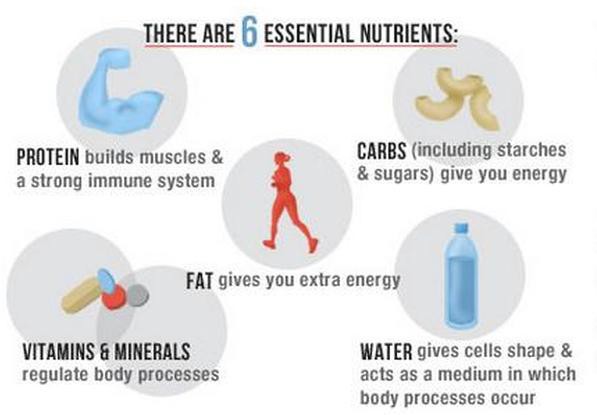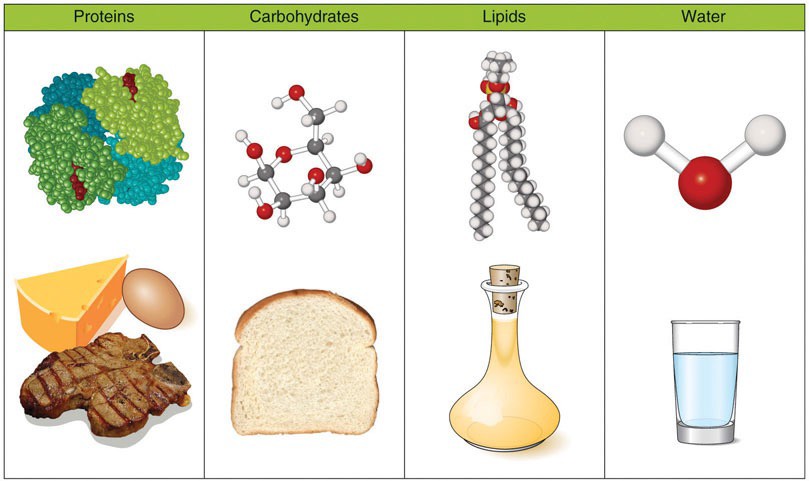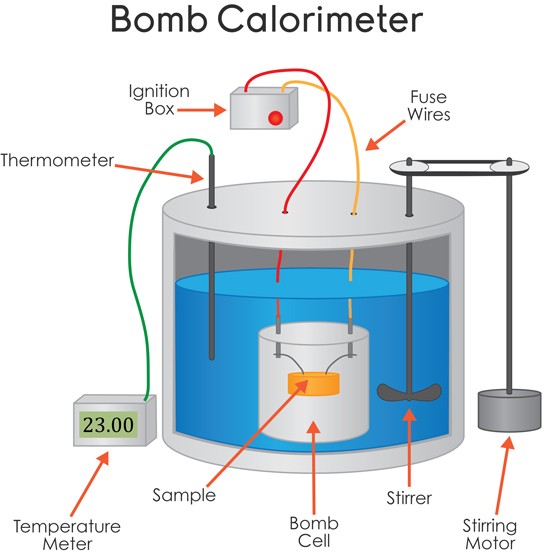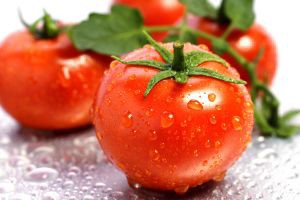Chapter 1: Nutrition and You
1.2 What Are Nutrients?
What’s in Food?
The foods we eat contain nutrients. Nutrients are substances the body needs to stay healthy. Essential nutrients are substances we must consume to stay healthy. For example, vitamin D is not an essential nutrient as the body makes enough when exposed to sunlight. In the Northwest, however, during Fall and Winter we typically don’t get enough sunlight exposure to produce vitamin D and we must get it from our diet. This is the point at which a nutrient becomes essential, when we must consume it for good health.
Nutrients are used to produce energy, detect and respond to environmental surroundings, move, excrete wastes, respire, (breathe), grow, and reproduce. There are six classes of nutrients required for the body to function and maintain overall health (Figure 1.21). These are carbohydrates, lipids, proteins, water, vitamins, and minerals. Foods also contain non-nutrients that may be harmful (such as cholesterol, dyes, and preservatives) or beneficial (such as antioxidants). Non-nutrient substances in food will be further explored in later chapters.

MACRONUTRIENTS
Nutrients that are needed in large amounts are called macronutrients. There are three classes of macronutrients: carbohydrates, lipids, and proteins (Figure 1.22). These can be metabolically processed into cellular energy. The energy from macronutrients comes from their chemical bonds. This chemical energy is converted into cellular energy that is then utilized to perform work, allowing our bodies to conduct their basic functions. A unit of measurement of food energy is the calorie. On nutrition food labels, the amount given for “calories” is actually equivalent to each calorie multiplied by one thousand. A kilocalorie (one thousand calories, denoted with a small “c”) is synonymous with the “Calorie” (with a capital “C”) on nutrition food labels. Water is also a macronutrient in the sense that you require a large amount of it, but unlike the other macronutrients it does not yield calories.

Carbohydrates
Carbohydrates are molecules composed of carbon, hydrogen, and oxygen in a 1:2:1 ratio. The major food sources of carbohydrates are grains, milk, fruits, and starchy vegetables like potatoes. Non-starchy vegetables also contain carbohydrates, but in lesser quantities.
When you consume carbohydrates, the amount of sugar (glucose) in your blood increases. Carbohydrates are broadly classified into two forms based on how they affect your blood sugar: fast-releasing carbohydrates, often called simple sugars, and slow-releasing carbohydrates.
Fast-releasing carbohydrates cause a rapid rise in blood sugar, followed by a drop. This pattern of blood sugar may be associated with diabetes and cardiovascular disease and may cause you to feel hungry more quickly. Fast-releasing carbohydrates are found in refined grains and foods/drinks with added sugar. Structurally, these carbohydrates consist of one or two basic units, which is why they can be called simple sugars. Examples of simple sugars include sucrose, the type of sugar you would have in a bowl on the breakfast table, and glucose, the type of sugar that circulates in your blood.
Slow-releasing carbohydrates raise your blood sugar but the effect is slower, spread out over time. These carbohydrates are long chains of simple sugars that can be branched or unbranched. During digestion, the body breaks down all slow-releasing carbohydrates to simple sugars, mostly glucose. Glucose is then transported to all our cells where it is stored, used to make energy, or used to build macromolecules. Fiber is also a slow-releasing carbohydrate, but it cannot be broken down in the human body and passes through the digestive tract undigested unless the bacteria that inhabit the gut break it down.
In addition to providing energy and serving as building blocks for bigger macromolecules, carbohydrates are essential for proper functioning of the nervous system, heart, and kidneys. As mentioned, glucose can be stored in the body for future use. In humans, the storage molecule of carbohydrates is called glycogen and in plants, it is known as starches. Glycogen and starches are slow-releasing carbohydrates.
Lipids
Lipids are also a family of molecules composed of carbon, hydrogen, and oxygen, but unlike carbohydrates, they are insoluble in water. Lipids are found predominately in butter, oils, meats, dairy products, nuts, and seeds, and in many processed foods. The three main types of lipids are triglycerides (triacylglycerol), phospholipids, and sterols. The main job of lipids is to store energy. Lipids provide more energy per gram than carbohydrates (nine kilocalories per gram of lipids versus four kilocalories per gram of carbohydrates). In addition to energy storage, lipids serve as cell membranes, surround and protect organs, aid in temperature regulation, and regulate many other functions in the body.
Proteins
Molecules composed of chains of amino acid subunits are called proteins. Amino acids in turn, are simple subunits composed of carbon, oxygen, hydrogen, and nitrogen. The food sources of proteins are meats, dairy products, seafood, and a variety of different plant-based foods, most notably soy. The word protein comes from a Greek word meaning “of primary importance,” which is an apt description of these macronutrients. Proteins provide four kilocalories of energy per gram; however, providing energy is not protein’s most important function. Proteins provide structure to bones, muscles and skin, and play a role in conducting most of the chemical reactions that take place in the body. Scientists estimate that greater than one-hundred thousand different proteins exist within the human body.
Water
There is one other nutrient that we must have in large quantities: water. Water does not contain carbon, but is composed of two hydrogens and one oxygen per molecule of water. More than 60 percent of your total body weight is water. Without it, nothing could be transported in or out of the body, chemical reactions would not occur, organs would not be cushioned, and body temperature would fluctuate widely. According to the “rule of threes,” a generalization supported by survival experts, a person can survive three minutes without oxygen, three days without water, and three weeks without food. Since water is so critical for life’s basic processes, the amount of water input and output is supremely important.
MICRONUTRIENTS
Micronutrients are nutrients required by the body in lesser amounts, but are still essential for carrying out bodily functions. Micronutrients include all the essential minerals and vitamins. There are sixteen essential minerals and thirteen vitamins (See Table 1.21 “Minerals and Their Major Functions” and Table 1.22 “Vitamins and Their Major Functions” for a complete list and their major functions). In contrast to the macronutrients, the micronutrients are not directly used for making energy, but they assist in the process as being part of enzymes (i.e., coenzymes). Enzymes are proteins that catalyze chemical reactions in the body and are involved in all aspects of body functions from producing energy, to digesting nutrients, to building macromolecules. Micronutrients play many roles in the body.
Minerals
Minerals are solid inorganic substances that form crystals and are classified depending on how much of them we need. Trace minerals such as zinc, iron, or iodine are only required in a few milligrams or less per day. While major minerals such as calcium, sodium, and potassium are required in hundreds of milligrams per day. Many minerals are critical for enzyme function, others are used to maintain fluid balance, build bone tissue, synthesize hormones, transmit nerve impulses, contract and relax muscles, and protect against harmful free radicals.
Table 1.21 Minerals and Their Major Functions
|
MAJOR MINERALS |
MAJOR FUNCTION |
|
Sodium |
Fluid balance, nerve transmission, muscle contraction |
|
Chloride |
Fluid balance, stomach acid production |
|
Potassium |
Fluid balance, nerve transmission, muscle contraction |
|
Calcium |
Bone and teeth health maintenance, nerve transmission, muscle contraction, blood clotting |
|
Phosphorus |
Bone and teeth health maintenance, acid-base balance |
|
Magnesium |
Protein production, nerve transmission, muscle contraction |
|
Sulfur |
Protein production |
|
TRACE MINERALS |
MAJOR FUNCTIONS |
|
Iron |
Carries oxygen, assists in energy production |
|
Zinc |
Protein and DNA production, wound healing, growth, immune system function |
|
Iodine |
Thyroid hormone production, growth, metabolism |
|
Selenium |
Antioxidant |
|
Copper |
Coenzyme and iron metabolism |
|
Manganese |
Coenzyme |
Vitamins
Unlike minerals, vitamins are all organic compounds. The thirteen vitamins are categorized as either water-soluble or fat-soluble. The water-soluble vitamins are vitamin C and all the B vitamins. The fat-soluble vitamins are A, D, E, and K. Vitamins are required to perform many functions in the body such as making red blood cells, synthesizing bone tissue, and playing a role in normal vision, nervous system function, and immune system function. Vitamin deficiencies can cause severe health problems. For example, a deficiency in niacin causes pellagra. Until scientists found out that better diets relieved the signs and symptoms of pellagra, many people with the disease ended up in insane asylums awaiting death (watch the video link below). Other vitamins were also found to prevent certain disorders and diseases such as scurvy (vitamin C), night blindness (vitamin A), and rickets (vitamin D).
Video Link: Pellagra
This video provides a brief history of Dr. Joseph Goldberger’s discovery that pellagra was a diet-related disease.
Table 1.22 Vitamins and Their Major Functions
|
WATER-SOLUBLE VITAMINS |
MAJOR FUNCTIONS |
|
B1 (thiamine) |
Coenzyme, energy metabolism assistance |
|
B2 (riboflavin) |
Coenzyme, energy metabolism assistance |
|
B3 (niacin) |
Coenzyme, energy metabolism assistance |
|
B5 (pantothenic acid) |
Coenzyme, energy metabolism assistance |
|
B6 (pyroxidine) |
Coenzyme, amino acid synthesis assistance |
|
B7 (biotin) |
Coenzyme |
|
B9 (folate) |
Coenzyme, essential for growth |
|
B12 (cobalamin) |
Coenzyme, red blood cell synthesis |
|
C |
Collagen synthesis, antioxidant |
|
FAT-SOLUBLE VITAMINS |
MAJOR FUNCTIONS |
|
A |
Vision, reproduction, immune system function |
|
D |
Bone and teeth health maintenance, immune system function |
|
E |
Antioxidant, cell membrane protection |
|
K |
Bone and teeth health maintenance, blood clotting |
Food Energy
Food energy is measured in kilocalories (kcals), commonly referred to as Calories. This terminology is technically incorrect, but is used so commonly that we will refer to them as calories throughout the course. A kilocalorie is the amount of energy needed to raise 1 kilogram of water 1 degree Celsius. A food’s kilocalories are determined by putting the food into a bomb calorimeter and determining the energy output (energy = heat produced). The link below is to a video of a bomb calorimeter showing how one is used.

Video Link: Bomb Calorimeter Measuring Energy in Food Digestion
This video shows how a bomb calorimeter is used to measure the energy in food
Among the nutrients, the amount of kilocalories per gram that each provide are shown below, along with the nutrients that do not provide energy.
| Energy (kcal/g) | No Energy |
| Carbohydrates (4 kcal/g) | Vitamins |
| Protein (4 kcal/g) | Minerals |
| Lipids (9 kcal/g) | Water |
As can be seen, only carbohydrates, proteins, and lipids provide energy. However, there is another energy source in the diet that is not a nutrient: alcohol. Just to re-emphasize, alcohol is NOT a nutrient! However, it does provide energy. In fact, alcohol provides seven kilocalories per gram.

Phytochemicals, Zoochemicals, and Functional Foods
Beyond macronutrients and micronutrients, there is a lot of interest in non-nutritive compounds found in foods that may be either beneficial or detrimental to health.
Phytochemicals
Phytochemicals are compounds in plants (phyto) that are believed to provide health benefits beyond the traditional nutrients. One example is lycopene in tomatoes, which is thought to potentially decrease the risk of some cancers (in particular prostate cancer). Diets rich in fruits and vegetables have been associated with decreased risk of chronic diseases. Many fruits and vegetables are rich in phytochemicals, leading some to hypothesize that phytochemicals are responsible for the decreased risk of chronic diseases. The role that phytochemicals play in health is still in the early stages of research, relative to other areas of nutrition such as micronutrients. The Linus Pauling Institute has a website containing good information on phytochemicals if you are interested in learning more about them (web link below).

Web Link: Linus Pauling Institute: Phytochemicals
Zoochemicals
Zoochemicals are the animal equivalent of phytochemicals in plants. They are compounds in animals that are believed to provide health benefits beyond the traditional nutrients that food contains. Hopefully the name is pretty easy to remember because you can find animals at a zoo. Some compounds can be both phytochemicals and zoochemicals. An example of compounds that can be classified as both are the yellow carotenoids lutein and zeaxanthin. Kale, spinach, and corn contain phytochemicals and are good sources of lutein and zeaxanthin. Whereas egg yolks contain zoochemicals and are also a good source of these carotenoids.
Functional Foods
There are a number of definitions of functional foods. Functional foods are generally understood to be a food, or a food ingredient, that may provide a health benefit beyond the traditional nutrients (macro and micronutrients) it contains. Functional foods are often a rich source of a phytochemical or zoochemical, or contain more of a certain nutrient than a normal food.
Food Quality
One measurement of food quality is the amount of nutrients it contains relative to the amount of energy it provides. High-quality foods are nutrient dense, meaning they contain many of the nutrients relative to the amount of calories they provide. Nutrient-dense foods are the opposite of “empty-calorie” foods, such as carbonated sugary drinks, or sweet and buttery pastries, which contain a high number of calories and very few nutrients. Food quality is additionally associated with its taste, texture, appearance, microbial content, and how much consumers like it.
Food: A Better Source of Nutrients
It is better to get all your micronutrients from the foods you eat as opposed to from supplements. Supplements contain only what is listed on the label, but foods contain many more macronutrients, micronutrients, and other chemicals, like antioxidants that benefit health. While vitamins, multivitamins, and supplements are a $20 billion industry in this country and more than 50 percent of Americans purchase and use them daily, there is no consistent evidence that they are better than food in promoting health and preventing disease. Dr. Marian Neuhouser, associate of the Fred Hutchinson Cancer Research Center in Seattle, says that “…scientific data are lacking on the long-term health benefits of supplements. To our surprise, we found that multivitamins did not lower the risk of the most common cancers and also had no impact on heart disease.”[1]
- Woodward, K. “Multivitamins Each Day Will Not Keep Common Cancers Away; Largest Study of Its Kind Provides Definitive Evidence that Multivitamins Will Not Reduce Risk of Cancer or Heart Disease in Postmenopausal Women.” Fred Hutchinson Cancer Research Center. Center News 16 (February 2009). https://www.fredhutch.org/en/news/center-news/2009/02/multivitamins-common-cancers.html ↵
Fast-releasing carbohydrates, often called simple sugars, are quickly broken down to provide energy. ( see slow-releasing carbohydrates)
The process of breaking down food into its component parts is called digestion. Both chemical and mechanical break down occur in the digestive tract.
Cells are the most basic building units of life. All living things are composed of cells.
Triglycerides are the main form of lipid found in the body and in the diet. A triglyceride molecule consists of a glycerol backbone attached to three fatty acids.
Phospholipids are molecules with two fatty acids and a phosphate group attached to a glycerol backbone. The fatty acids give a phospholipid a hydrophobic "tail" and the phosphate group gives the phospholipid a hydrophilic "head".
Sterols are complex molecules related to cholesterol that contain interlinking rings of carbon atoms, with side chains of carbon, hydrogen, and oxygen attached.
Organs are a group of tissues arranged in a specific manner to support a common physiological function.
Trace minerals are classified as minerals required in the diet each day in smaller amounts, specifically 100 milligrams or less. These include copper, zinc, selenium, iodine, chromium, fluoride, manganese, molybdenum, and others.
Fluid balance refers to maintaining the distribution of water in the body.
A hormone is a compound that is produced in one tissue, released into circulation, then has an effect on a different organ.
Free Radical – a molecule with an unpaired electron in its outer orbital. Free radicals are highly reactive because they actively seek an electron to stabilize (pair with) the unpaired electron within the molecule. This makes free radicals very strong oxidants.
Water-soluble molecules are molecules that dissolve in water, not in oils. Water-soluble nutrients are absorbed directly into the bloodstream. Excess water-soluble vitamins are removed in the urine.
Fat-soluble molecules are molecules that dissolve in oils and other lipids, not in water. Fat-soluble nutrients are found in foods containing fat and are absorbed first into the lymphatic system and then moved to the blood system. Excess fat-soluble vitamins are stored in fatty tissue or the liver.
Niacin deficiency is commonly known as pellagra. Symptoms include fatigue, decreased appetite, and indigestion and are commonly followed by the four D’s: diarrhea, dermatitis, dementia, and sometimes death.
Insufficient vitamin D during childhood causes rickets, a disorder characterized by soft, weak, deformed bones that are exceptionally susceptible to fracture.
About 10 percent of plant-derived carotenoids, including beta-carotene, can be converted in the body to retinoids and are another source of functional vitamin A. Carotenoids are pigments synthesized by plants that give them their yellow, orange, and red color.

